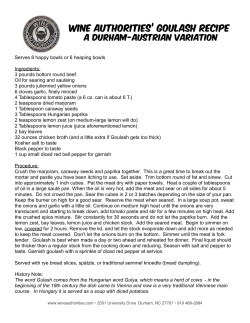
lm a b on
Directorate Plant Production Private Bag X250 PRETORIA 0001 Tel: +27 12 319 6072 Fax +27 12 319 6372 Email Thabo.Ramashala@daff.gov.za Further information can be obtained from: We thank the members of SAEOPA and KARWIL consultancy for information provided. Acknowledgement Lemon balm is susceptible to mildew. Several practices will reduce or prevent powdery mildew. Do not plant in low, shady locations. Whitefly, spider mite and thrips are pests that occur on lemon balm. Pest and disease control PRETORIA 0001 Resource Centre Directorate Communication Services Private Bag X144 Obtainable from Department of Agriculture, Forestry and Fisheries Printed and published by 2012 (revised) Department: Agriculture, Forestry and Fisheries REPUBLIC OF SOUTH AFRICA agriculture, forestry & fisheries Melissa officinalis Family: Labiatae Lemon balm • Fresh or dried leaves are used in health tea and other tea blends. • The oil is used in perfume. Uses Lemon balm should be cultivated in temperate and subtropic regions. Rainfall of 300 to 1 300 mm per annum is necessary, however, it should be watered regularly if rainfall is not sufficient. Lemon balm grows best in fertile, deep, and well-drained soils with a pH of 5,0 to 7,5. Climatic and soil requirements Lemon balm is grown on a small scale in the Lowveld of Mpumalanga, KwaZulu-Natal, Gauteng and the Eastern and Western Cape provinces. Lemon balm is part of the mint family and indigenous to Southern Europe, the Mediterranean region, Western Asia, and North Africa. Origin and distribution Melissa officinalis is a spreading herb with a short rootstock and square branching stems that grow 30 to 60 cm high. The top of the plant dies down in winter, the root, however, is perennial. Essential oil crops are crops that have volatile, aromatic oils in certain parts of the plant. Essential oils are natural plant products which accumulate in specialised structures such as oil cells, glandular trichomes, and oil or resin vessels. The oil is extracted from the plant through steam distillation, chemical extraction or CO2 extraction. Background Lemon balm spreads rapidly (Photos: W.G. Alberts) Although specific recommendations are not available for fertilisation of lemon balm, yield and oil content Fertilisation Lemon balm grows easily from seed sown in the spring or early autumn. Direct seeding can be done at 7 to 9 kg/ha. Stolons are the faster and easier way to establish lemon balm. Propagation The planting density should be 45 000 to 100 000 plants/ha. Suggested spacing is 20 to 30 cm apart in the row, and 50 to 75 cm between the rows. There are no herbicides cleared for use on lemon balm as the plant is used mostly for medicinal purposes, and toxic elements have to be eliminated as far as possible. Weed control programmes must be maintained strictly. Weed control The crop has a high water demand. A regular water supply should be provided by overhead sprinkler irrigation. Always avoid excess water as it is harmful to the crop. Irrigation Cultural practices Planting may be increased with several nitrogen applications during the growing season. • The leaves and flowers are also used in winemaking and liqueurs.
© Copyright 2025


















